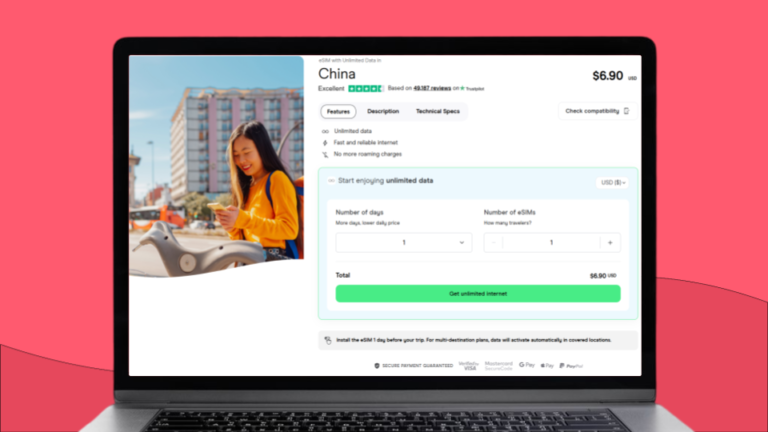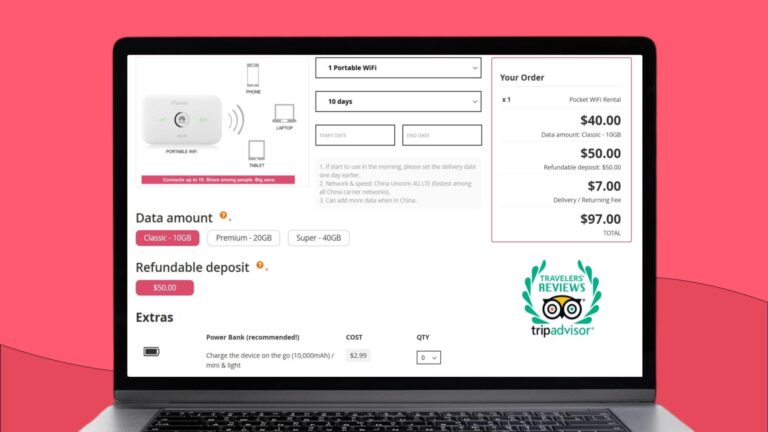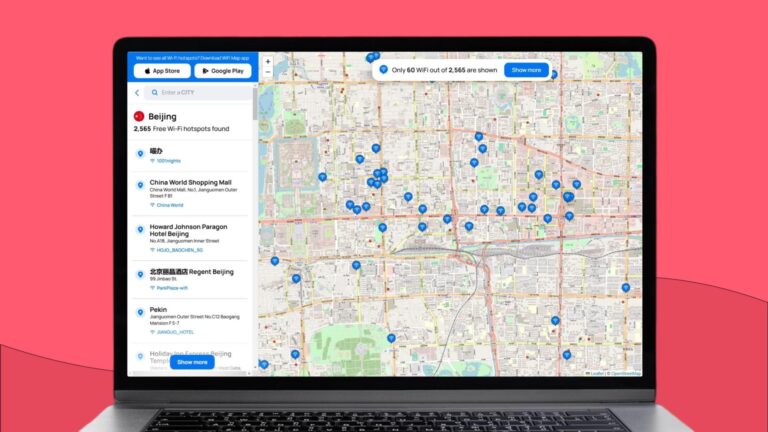Internet in China for tourists: How to stay connected
Learn how to access the internet in China for tourists. Explore eSIMs with VPNs, pocket WiFi, free WiFi, and tips to bypass the Great Firewall effectively.
Using the internet in China is a unique challenge for foreign travelers because it has strict online restrictions and functions as a closed system. Platforms like WeChat and Baidu dominate China’s internet, replacing foreign websites and apps like WhatsApp and Google. So, even though you can get online, many of your usual ways to stay connected would be cut off.
This guide explores reliable international internet services, from eSIMs that work in China to pocket and free WiFi. Here’s how to use your phone in China.
Can tourists use Google in China?
Tourists can’t use Google in China in the way that they are used to. The government in China implements strict internet restrictions, often called the “Great Firewall of China.” It blocks numerous internet services, including Google, Facebook, Instagram, Twitter, WhatsApp, and even popular news portals like The New York Times.
To overcome the Great Firewall, travelers must use a VPN (Virtual Private Network). A VPN encrypts your connection, allowing you to bypass restrictions and access blocked websites and apps. However, finding a reliable VPN that works within China’s system is essential, as not all VPNs can get around the Great Firewall effectively.
How to access the internet in China without limitations
A VPN is essential to bypass restrictions and use popular apps and services. There are two ways to get internet access in China for tourists.
Get your own VPN
If you decide to do your own research and get a VPN, make sure you install and test it before you arrive in China. If you wait until arrival, you may not be able to activate or access the VPN.
Other than that, choose a VPN that:
- Has a strong reputation for bypassing internet access restrictions.
- Offers consistent speeds for internet in China.
- Provides apps for your devices and robust encryption.
If this sounds like too much work, there’s an easy way out:
Get an eSIM with a VPN already built-in
eSIM providers like Holafly offer packages with a built-in VPN, eliminating the need to search Reddit and review websites for recommendations on how to access the internet in China.
These eSIMs connect to local networks while automatically encrypting your connection to bypass restrictions. It’s a convenient option if you want reliable internet access without the additional costs or trouble of managing separate VPN apps.
Mobile internet in China: Best options for tourists
For many tourists unfamiliar with the Chinese language, internet access in China can feel overwhelming. While a local China SIM card is an option, it will require registration, and internet cafes are harder to find in China these days. This means you need a better and more reliable way to avoid using data roaming on your trip. Data roaming is notoriously expensive, and even if you have some sort of a roaming pass from your provider, the charges ramp up very fast.
Considering all the limitations of these connectivity methods, an eSIM for mobile internet connection is the go-to choice for most tourists.
Here are the best ways to stay online during your trip.
Unlimited data eSIM with VPN for China
An eSIM is a digital SIM card that you can activate without swapping physical SIMs.
Seasoned travelers often prefer eSIMs for staying connected during their trips because it takes minutes to buy and activate them, you can have multiple eSIMs at the same time, and they offer the same quality of connection as a local SIM card.
Here’s how it works:
- Quick setup: If your phone is eSIM-compatible, you can buy your eSIM online and activate it by scanning a QR code sent by the provider.
- Data-only plans: Your eSIM will most probably come with a data plan, without an SMS or voice call options. However, your primary SIM card remains active and can function alongside the eSIM.
- No roaming fees: Use your data plan without worrying about high roaming fees from your primary carrier.
Holafly eSIM for China
Not all eSIMs have the same prices and features. Here’s why Holafly’s eSIM for China makes the most sense for having a reliable connection with a VPN included.

Over 1 million people have already used Holafly eSIM to stay connected on their travels. Here are some reasons why all these people chose this particular eSIM.
- Unlimited data: Holafly offers unlimited data packages, so you won’t have to worry about running out of data during your trip.
- Built-in VPN: Holafly’s built-in VPN makes navigating China’s internet censorship easy and enables access to your favorite mobile apps, such as Facebook, Twitter, YouTube, Google Maps, and more.
- Flexible durations: You can choose a plan length that fits your trip, from 1 to 90 days.
- Reliable speeds: Holafly connects to major networks like China Mobile, ensuring you have a great connection, the same as you’d have with a local SIM card.
- Holafly Connect: an alternative ideal for long-term travelers. With it, they can get monthly eSIM subscription plans and enjoy reliable, contract-free internet wherever they go!
- Multi-destination plans: Traveling across Asia? Holafly’s multi-destination plans go wherever you go. Visiting Japan and China? The eSIM for Japan and China keeps you connected. For longer trips, the eSIM for Asia ensures seamless connectivity throughout your journey.
These are the prices for the plans people most commonly choose to stay connected in China.
| Days | Data | Price (USD) | Daily price (USD) |
|---|---|---|---|
| 1 | Unlimited | $6.90 | $6.90 |
| 5 | Unlimited | $20.90 | $4.18 |
| 10 | Unlimited | $36.90 | $3.69 |
| 15 | Unlimited | $50.90 | $3.39 |
| 30 | Unlimited | $74.90 | $2.50 |
| 60 | Unlimited | $106.90 | $1.78 |
| 90 | Unlimited | $139.90 | $1.55 |
Pocket WiFi for internet in China
A pocket WiFi device for China is a portable wireless router that creates a personal hotspot. It allows you to share your WiFi with a group or connect multiple devices at the same time. These devices work in China because they usually come with a built-in VPN.
However, most travelers choose eSIM over pocket WiFi mainly because they must arrange the pick-up and drop-off of the device, pay a security deposit, and always carry another device with them. Also, the price is usually high.
Here are some of the best offers for a pocket WiFi device with a VPN for secure access to restricted sites like Google and Facebook.
- Cellular Abroad: This is the most cost-effective solution at $12 USD per day, supporting up to 10 devices with included VPN access. The minimum rental period is 7 days, and they deliver to hotels or your home address.
- Travelers WiFi: They charge $36.60 USD for the first day, with better rates for longer rentals. Portable WiFi devices support up to five simultaneous connections and ship to most locations worldwide.
- 3G Solutions: Pricing starts at $12 daily for 3 GB (Classic) with options for 6 GB (Premium) and 12 GB (Super). On top of this, there’s a refundable deposit of $50 USD $12.99 USD for VPN.

Free WiFi
Free WiFi is widely available in China in restaurants, cafes, airports, hotels, trains, and train stations. It is especially prevalent in urban areas like Beijing. However, it might not work as well as you are used to.
Here’s what to keep in mind regarding internet access using Chinese public networks:
- Public WiFi in China often requires SMS verification: To get this type of internet access, you need a Chinese phone number SMS or be able to receive SMS to your primary number.
- You still need a VPN: Like any other internet connectivity option in China, you’ll have to use a VPN to access apps blocked by the Great Firewall.
- Free WiFi is unreliable: Be careful when using Chinese public WiFi in cities like Beijing, leaving your data vulnerable to hackers. It’s advisable to avoid sensitive activities like e-banking. You can use apps such as WiFimap to find available hotspots.

How to get internet in China: A comparison
The internet in China doesn’t work the same as the rest of the world. So, learning how to use the internet in China may be difficult, especially because some options require you to understand VPN technology or pay hefty daily rental fees.
| Option | Key features | Ideal for | Cost (USD) |
|---|---|---|---|
| Holafly eSIM | Unlimited data, built-in VPN, flexible plans | All travelers, people seeking unlimited connectivity throughout the country | From $6.90/day |
| Pocket WiFi | Connect multiple devices, built-in VPN | Group travelers, multiple device users | From $12/day (e.g., 3G Solutions) |
| Free WiFi | Registration necessary, requires VPN | Casual browsing, local Chinese internet only | Free, but security risks |
Holafly eSIM: Keep using your favorite apps even in China
Luckily, you are not the first one who wants an easy way to access the global internet and websites such as Facebook or YouTube on your travels to China. The answer for you is Holafly eSIM with unlimited data and a built-in VPN. It’s all you need to connect and avoid censorship, especially to avoid the WhatsApp blockage in China.
Pocket WiFi offers a good alternative for group travelers or those with multiple devices. Options like Cellular Abroad or Travelers WiFi cater to such needs but come with added logistics and much higher upfront costs. Unless you need to connect several devices at all times, this is not the best option.
While free WiFi might seem appealing, its limitations and security risks make it a less reliable choice. Even if you manage to register and connect to the local free WiFi, you won’t be able to avoid the Great Firewall.
To enjoy a worry-free trip, plan your connectivity in advance and choose a solution that keeps you connected in urban and rural areas at a fair price and a connection quality that matches that of a local SIM card.
China has vast coverage across its major cities, and visitors often combine their trip with these nearby countries for seamless mobile internet access.
- Mobile internet in Hong Kong
- Mobile internet in Japan
- Mobile internet in India
- Mobile internet in Vietnam
- Mobile internet in Singapore





 Language
Language 


















 No results found
No results found














